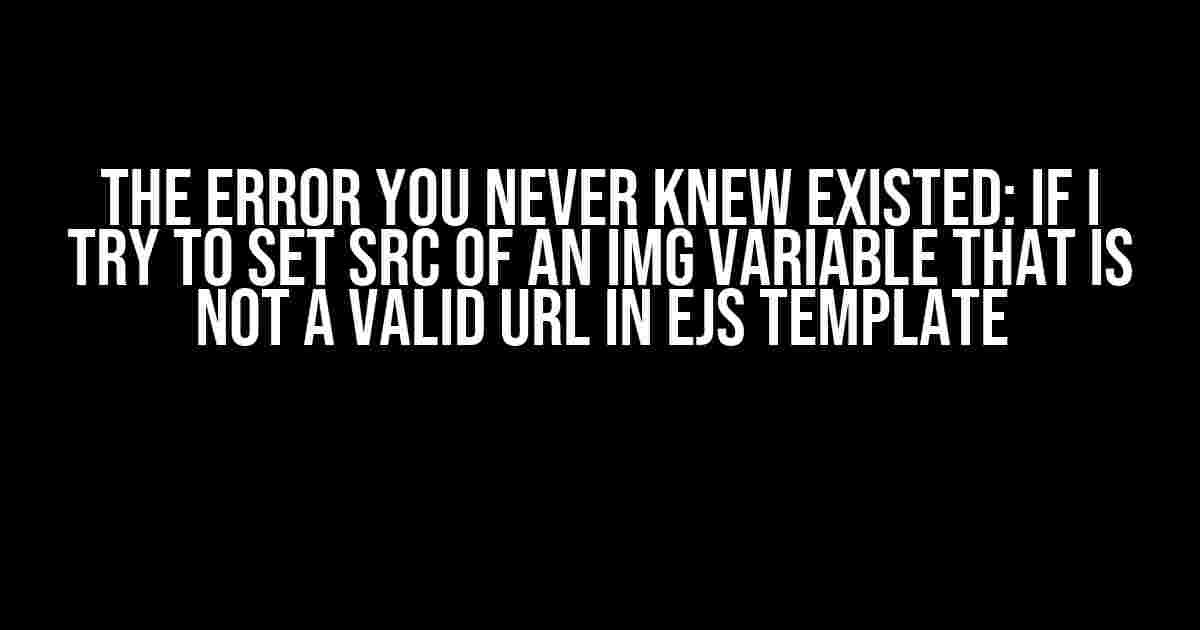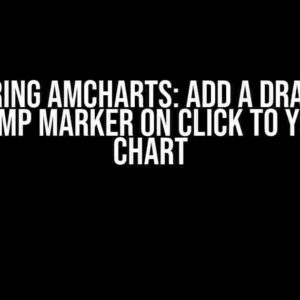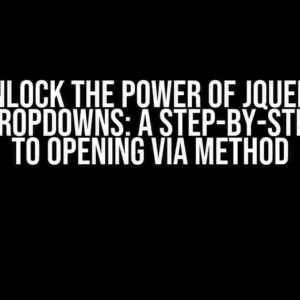Are you tired of encountering errors that seem to appear out of thin air? Have you ever tried to set the src of an img variable in an EJS template only to be met with a cryptic error message that leaves you scratching your head? Well, you’re not alone! In this article, we’ll delve into the mysterious realm of EJS templates and explore the often-overlooked error that occurs when you try to set the src of an img variable with an invalid URL.
What is EJS?
Before we dive into the error, let’s take a brief detour to understand what EJS (Embedded JavaScript) is. EJS is a templating engine that allows you to inject JavaScript code into your HTML templates. It’s a popular choice among developers due to its ease of use, flexibility, and compatibility with most web frameworks.
How EJS Works
EJS templates consist of HTML code interspersed with JavaScript code. The JavaScript code is executed on the server-side, allowing you to dynamically generate content based on variables, conditional statements, and loops. When an EJS template is rendered, the JavaScript code is executed, and the resulting HTML is sent to the client’s browser.
The Error: If I Try to Set Src of an Img Variable that is Not a Valid URL
Now, let’s get to the meat of the matter! The error in question occurs when you attempt to set the src attribute of an img element using an EJS variable that contains an invalid URL. For example:
<img src=<%= imgUrl %> alt="Image">
Here, the variable imgUrl contains a string that is not a valid URL. This could be due to a typo, a misconfigured server, or any other reason that would render the URL invalid.
The Error Message
When you try to render an EJS template with an invalid URL, you’ll likely encounter an error message that looks something like this:
Error: Failed to load resource: the server responded with a status of 404 (Not Found)
Or, in some cases, you might see a more cryptic error message like:
Error: Unable to render template
Either way, the error message is not very helpful, leaving you wondering what went wrong.
Why Does This Error Occur?
The error occurs because the EJS template engine is trying to access the URL specified in the src attribute. When the URL is invalid, the server returns a 404 error, which is then propagated to the EJS engine. Since the EJS engine is unable to render the template with an invalid URL, it throws an error.
How to Fix the Error
So, how do you fix this error? Well, it’s easier than you think! Here are a few strategies to help you resolve the issue:
-
Check the URL
Make sure the URL is valid and correctly formed. Check for typos, incorrect protocol (http/https), and ensure the URL is correctly encoded.
-
Use a Fallback URL
If the URL is dynamically generated, consider using a fallback URL or a default image as a backup. This way, even if the primary URL is invalid, the fallback URL can still be used.
-
Validate the URL
Use JavaScript to validate the URL before setting the src attribute. You can use a regular expression or a library like URL.js to validate the URL.
-
Use a Try-Catch Block
Wrap the img tag in a try-catch block to catch any errors that occur when setting the src attribute. This way, you can handle the error gracefully and provide a fallback experience for the user.
Example Code
Here’s an example of how you could implement a try-catch block to handle the error:
<% try { %>
<img src=<%= imgUrl %> alt="Image">
<% } catch (e) { %>
<img src="fallback-url.jpg" alt="Fallback Image">
<% } %>
In this example, if the imgUrl variable contains an invalid URL, the try-catch block will catch the error and render the fallback image instead.
Conclusion
In conclusion, the error “If I try to set src of an img variable that is not a valid URL in EJS template” is a common gotcha that can be easily avoided with a little vigilance and creative problem-solving. By understanding the root cause of the error and implementing the strategies outlined above, you can ensure that your EJS templates render correctly and provide a seamless user experience.
Best Practices
To avoid this error in the future, follow these best practices:
- Validate user-generated URLs
- Use fallback URLs or default images
- Test your EJS templates thoroughly
- Use try-catch blocks to handle errors
Final Thoughts
In the world of web development, errors are an inevitable part of the journey. However, with a little patience, persistence, and creativity, you can overcome even the most obscure errors. Remember, the next time you encounter an error, take a step back, breathe, and think like a detective – the solution is just a few clever moves away!
| Common Causes of the Error | Solutions |
|---|---|
| Invalid URL | Validate the URL, use a fallback URL, or default image |
| Typos or incorrect protocol | Check the URL for typos and ensure correct protocol (http/https) |
| Dynamically generated URLs | Use a fallback URL or default image, validate the URL using JavaScript |
By following these best practices and being mindful of the common causes of the error, you can avoid the “If I try to set src of an img variable that is not a valid URL in EJS template” error and create robust, error-free EJS templates.
Here are 5 Questions and Answers about “If I try to set src of an img variable that is not a valid URL in an EJS template, it throws an error”:
Frequently Asked Question
Wondering why your EJS template is throwing an error when trying to set an invalid URL as the source of an image? We’ve got you covered!
Why does my EJS template throw an error when setting an invalid URL as the image source?
EJS templates will throw an error when trying to set an invalid URL as the source of an image because it’s trying to actually fetch the resource at that URL. If the URL is invalid, the browser can’t load the image, and the error is thrown.
Can I avoid this error by checking if the URL is valid before setting it as the image source?
Yes, you can avoid this error by checking if the URL is valid before setting it as the image source. You can use JavaScript to check if the URL is valid, and if not, set a default image or handle the error in a way that makes sense for your application.
What is a good way to validate the URL before setting it as the image source?
You can use a library like URL.js to validate the URL, or simply check if the URL starts with http:// or https://. You can also use a try-catch block to catch any errors that occur when trying to set the image source.
Can I set a placeholder image if the URL is invalid?
Yes, you can set a placeholder image if the URL is invalid. This can be done by setting a default image source in your JavaScript code, or by using a CSS technique like setting the image as a background image with a fallback.
Is there a way to prevent the error from being thrown entirely?
Yes, you can prevent the error from being thrown entirely by using a technique like setting the image source in an onload event handler, which will only set the source if the image is successfully loaded.




